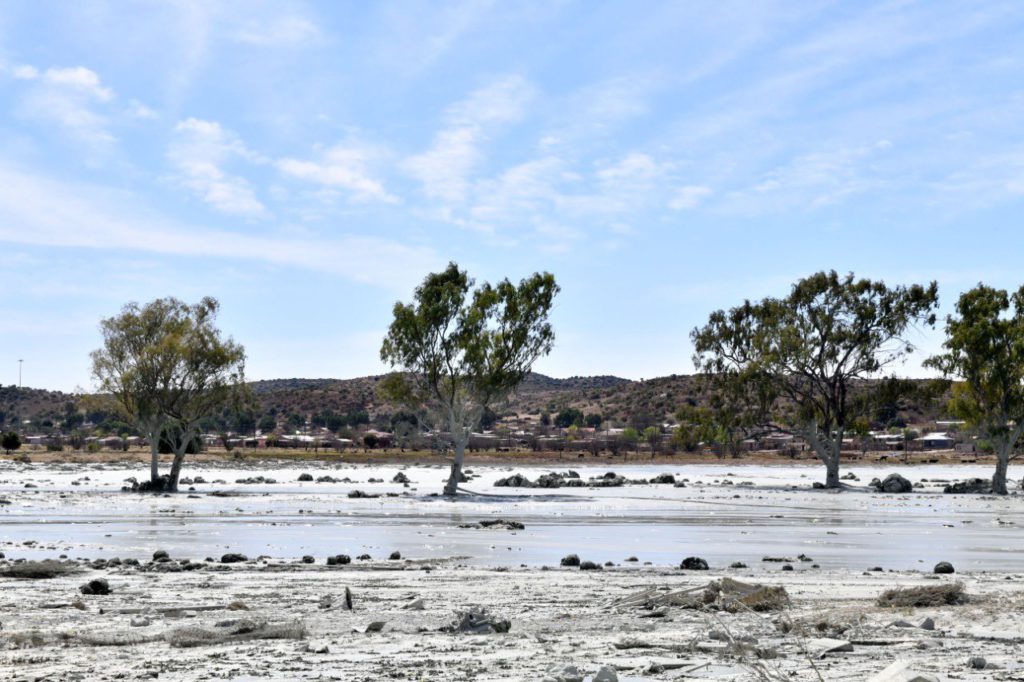Reuters |

The Jagersfontein-Charlesville area in the Free State where flooding from a disused mine has caused the evacuation of hundreds of people from their homes and the death of at least one person. Credit: South African Government’s Twitter page
A South African company is dumping the sludgy byproduct of mining into a historical diamond pit after the tailings dam that had stored the waste partially collapsed, killing one and leaving scores injured.

The government agency overseeing cultural preservation said on Thursday it approved plans to fill the historic Jagersfontein diamond mining pit with waste from a second compartment of the tailings dam in order to prevent a secondary breach after one compartment of the dam failed.
Public documents show Jagersfontein Developments, the company reprocessing old tailings around the disused pit to recover diamonds, has lodged five applications over the past decade with the South African Heritage Resources Agency (SAHRA) seeking permission to store liquid mine waste that is a byproduct of that reprocessing in the pit rather than the dam.
The latest request was made on Aug. 17, just four weeks before the tailings dam disaster.
An earlier decision to move the waste into the pit could have relieved pressure on the tailings dam which burst on Sunday morning, unleashing a flood of gray sludge that swept away houses and cars in Jagersfontein, a small town in South Africa’s Free State province.
But the pit, the oldest and biggest hand-dug diamond mine in the world, is classed as a historical site and filling it up requires approval by SAHRA.
The Department of Water and Sanitation authorised the “immediate” pumping of slime from the second compartment of the tailings dam into the pit on Monday, the day after the dam burst, prompting SAHRA to approve the backfilling on Thursday.
“As the town of Jagersfontein is in a state of disaster because of the collapsed tailings dam (…) no further assessment of the impact to heritage resources are required,” SAHRA said, adding it had no objections to the plan submitted on Aug. 17.
Jagersfontein Developments first applied to backfill the historical pit in September 2012, and SAHRA granted it permission in June 2013, but the Jagersfontein Community Trust appealed the decision and the company withdrew its application in January 2014.
SAHRA said the subsequent applications made by Jagersfontein Developments in 2018, 2019 and 2020 were incomplete.
Fortune seekers drawn by South Africa’s diamond rush started digging at Jagersfontein in 1870. By 1907 the pit was bigger even than the more famous “Big Hole” in Kimberley, and reached a depth of 250 metres (820 ft).
Since then it has changed hands multiple times.
De Beers, the diamond mining unit of Anglo American Plc, was the last company to mine Jagersfontein until 1971, selling the mine and surrounding dry tailings dumps in 2010 to Superkolong Consortium.
Dubai-based Stargems Group purchased the assets from the Luxembourg-based investment fund Reinet in April 2022. Reuters could not immediately establish when Reinet bought Jagersfontein from Superkolong, and Reinet did not respond to requests for comment.
Neither Stargems nor Jagersfontein Development, a Stargems subsidiary, replied to questions about their plans to backfill the pit.
Sunday’s disaster has raised questions about oversight of hundreds of tailings dams littered across South Africa.
In 2007 South Africa’s High Court ruled that the Jagersfontein tailings dumps do not fall under the purview of the mines ministry, meaning companies processing the dumps do not require a mining licence.
Visiting Jagersfontein on Tuesday, minerals and energy minister Gwede Mantashe criticised that ruling, saying it should be “revisited” so that the ministry can inspect tailings dams.
“A (tailings) dam, you can’t trust it, it can break anytime,” he said in a video posted on his Twitter account.
(By Nelson Banya and Helen Reid; Editing by Ernest Scheyder and Jonathan Oatis)
No comments:
Post a Comment